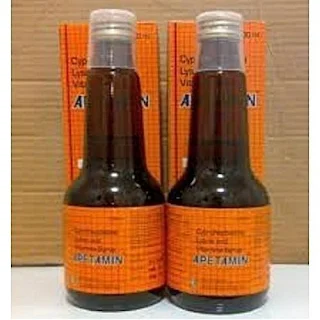Apetamin Syrup Composition, Use, Dose, Side Effect
Apetamin is a popular appetite stimulant. It is made by TIL healthcare Pvt ltd in India. It is banned in the United States of America (USA) federal drug agency (FDA). It is not banned in Nigeria. However, it has not been registered.
 |
| Apetamin syrup |
Composition Of Apetamin Syrup
Each 5 ml contains:
Cyproheptadine Hydrochloride (anhydrous) BP 2 mg
L-Lysine Hydrochloride USP 150 mg
Thiamine Hydrochloride BP 2 mg
Pyridoxine Hydrochloride BP 1 mg
Nicotinamide BP 15 mg
Dexpanthenol BP 4.5 mg
Color: Sunset yellow FCF
Uniqueness
Apetamin contains a unique combination of Cyproheptadine, Lysine and Vitamins. Cyproheptadine and Lysine being an essential and limiting amino acid helps to promote appetite. Besides helping in the synthesis of collagen tissue. Lysine also helps to improve immunity during infancy, childhood and adolescence.
Read Also: Difference and similarity between apetabon and apetamin
The water soluble vitamins in Apetamin being coenzymes helps to absorb the amino acid lysine through the intestinal villi faster and assist in better utilization of Lysine. They also improve immunity and help to correct marginal vitamin deficiency.
Pharmacokinetics
After absorption from the gastrointestinal tract Cyproheptadine hydrochloride undergoes almost complete metabolism in the liver. Metabolites are excreted principally in the urine as conjugates, and also in the feces.
Onset Of Action
15 to 20 minutes after oral ingestion.
Indications And Use Of Apetamin
- Loss of appetite and poor eating habits
- Anorexia after a brief illness
- Patients experiencing loss of appetite during convalescence following surgery or after any major illness.
Contraindications
There are no known contraindications but concomitant administration of other antihistamines and sedatives is contraindicated.
Symptoms And Treatment Of Overdosage
Antihistamine overdose reactions may vary from central nervous system depression to stimulation especially in children. Also, atropine-like signs and symptoms (dry mouth; fixed, dilated pupils; flushing, etc.) as well as gastrointestinal symptoms may occur.
If vomiting has not occurred spontaneously, the patient should be induced to vomit with syrup of ipecac.
If the patient is unable to vomit, perform gastric lavage followed by activated charcoal. Isotonic or ½ hypotonic saline is the lavage of choice. Precautions against aspiration must be taken especially in infants and children.
Pregnancy And Lactation
Safely in pregnancy and lactation has not been established.
Warnings
Children: Overdose of antihistamines, particularly in infants and children may produce hallucinations, central nervous system depression and convulsion.
Antihistamines may diminish mental alertness, conversely, particularly in the young child, they may occasionally produce excitation.
CNS Depressants: Antihistamines may have additive effects with alcohol and other CNS depressants, e.g. hypnotics, sedatives, tranquillisers, antianxiety agents.
Activities Requiring Mental Alertness: Patients should be warned about engaging in activities requiring mental alertness and motor coordination, such as driving a car or operating machinery.
Read Also: All about apetabon
Antihistamines are more likely to cause dizziness, sedation and hypotension in elderly.
Adverse Reactions And Precautions
Drowsiness to deep sleep, lassitude, dizziness, and in-coordination may occasionally occur especially in high doses. The sedative effect may diminish after a few days of treatment. It is suggested that the treatment is started with a lower dose to begin with and increased gradually over a period of days.
Interactions
Sedative antihistamines may enhance the sedative effects of CNS depressants including alcohol, barbiturates, hypnotics, etc.
Safety
It is generally safe to use both in children and adults. But precaution should be taken while using other CNS depressants and sedatives.
Dosage And Administration
Children (2-6 years): 5ml, 2 to 3 times daily before food
7-14 years: 10ml, 2 to 3 times daily before food.
Adults: 10ml, 3 times daily before food

Comments
Post a Comment
Please have your say